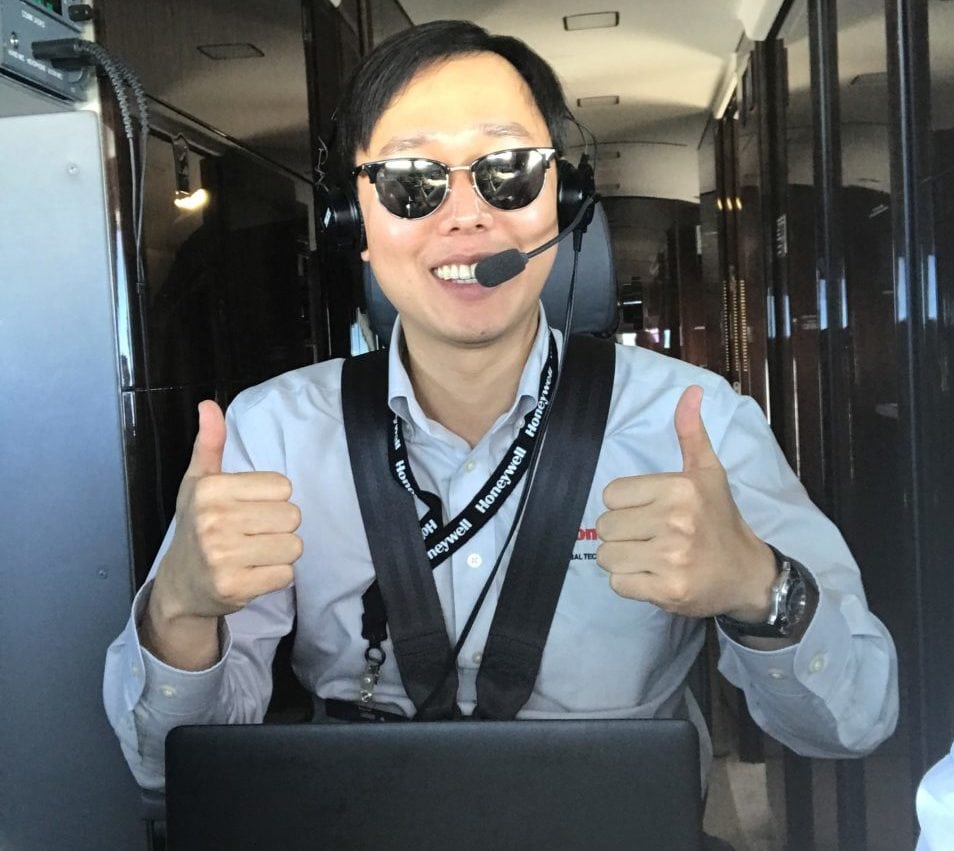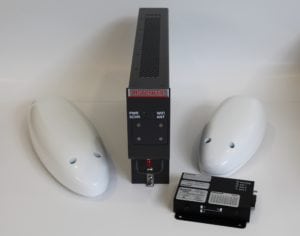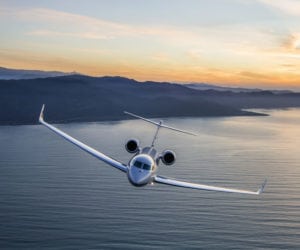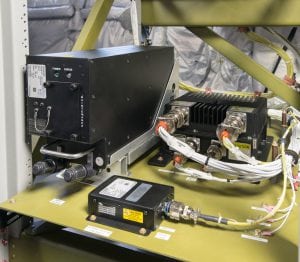
Honeywell engineer James Lee (Photo courtesy of Honeywell)
As a child in South Korea, James Lee never thought he’d be a major OEM’s go-to guy for satcom solutions. He had no idea he would be problem-solving for sports team owners, celebrities and billionaires from around the world. He just knew he was good at math.
After moving to Illinois before high school, he went to the University of Illinois for college where that aptitude led him to an engineering major, which set him on a path toward where he is today. A campus visit from a Honeywell Aerospace recruiter brought him to the company’s Phoenix, Arizona, headquarters for a summer internship, giving him what he called “his first taste of dry heat.”
After Lee’s 2005 graduation, it was right back to the desert, where he started as a quality engineer. He’s bounced around a little in his 13 years at Honeywell, but found a home with satcom, a field he sees is growing in both presence and importance. He recalls watching as CEOs would get satcom systems installed on one of their jets for the first time. He said that, despite having five or more jets, they would only fly on the one with the connectivity until it was added to others because of the difference it made.
Lee spoke to Avionics about the importance of satcom, Honeywell’s new JetWave system and what it’s like zipping around to provide crucial support to billionaires.
How did you go from your internship at Honeywell to being the guy for satcom?
In 2012, I was looking for something different and I had an opportunity to come in and learn satcom. Prior to that, I did not have any experience with satcom. From that point on, I’ve been doing the product support where I’ll be working with the OEMs at Airbus, Boeing, Embraer, Bombardier, various OEMs, as well as the operators, airlines and military. So, I really support all types of aviation business. And from then on, I started picking up other satcom.
We expanded my portfolio from supporting a multi-channel satcom, the MCS 7000 and MCS 7200 all the way to EMS Aspire HD710. The latest thing that Honeywell has been pushing is the JetWave, which is the latest Ka-band-based connectivity system that enables high speed — true high-speed — connection. This is going on multiple airlines at the moment as well as a lot of business jets. By the end of the year, we’ll have more than 1,000 aircraft flying with the JetWave system, so I have been very occupied with that support. Sometimes, I’ll support the installation — could be the OEM or it could be just an installation job. I’ll be going to the operators’ hangar to try to troubleshoot or maybe just do some training, some software update, etc. So that has been taking maybe half of my time recently.

Honeywell says its new Aspire 350 will keep pilots connected throughout their flights. Photo courtesy of Honeywell
What else do you do in your day-to-day at Honeywell as a senior product support engineer?
Basically, I’m the technical support engineer for Honeywell satcom system.
The products that I support vary from very old legacy satcom that’s purely used for cockpit safety services, making cabin phone calls all the way up to the JetWave Ka-band satcom system, which is for entertainment, for cabin use, giving you up to 15 megabits per second connection. I’ll get requests from airlines, business operators, OEMs for technical support. If they have issues with their system not working well or they need support with the log analysis, I’m going to walk them through it. And from there I determine whether I need the log to review it or I have to get dispatched to support them on site.
I give them direction on where they need to go; check this wiring or you need to replace this part because of that reason. Sometimes I’ll give them training.
I’ve got a couple conferences coming up where I’ll be giving a presentation on connectivity as well as some training.

A Gulfstream G650. Photo courtesy of Gulfstream
A lot of the satcom I work on will be large business jets. They are for major corporations or they are private, like billionaires, high upper echelon business jets: the Gulfstream G650, G550; Bombardier Global 6000, 5000; Dassault Falcon 7X, 900Lx, 2000s; Airbus; Boeing BBJ. I work with the airlines but mainly their director of maintenance will reach out or the engineer from the OEM or their product support group will reach out to me. I do a lot of remote sessions. What I’ll do is, before I go there in person, I’ll have them connect their laptops to a Honeywell system, and I go in there and go through the system look at the status, run some reports, do some testing to see if there’s something that I can fix on the spot or if it’s something I need to go there to do handholding, walk them through.
How often are you on the road, providing hands-on support?
Last year I did 63% travel. I’ll be on the road tonight or tomorrow.
One time, I went to Cincinnati to work with a financial company on a Falcon 7X. I went there on Thursday, I did the work on Friday, and then Friday evening I went to Chicago to spend some time with my parents because I had a job on Monday morning that I had to do in Chicago for a private jet operator on a couple of Globals. But on Saturday, I got called to a Global Express operator out in California. So, I went out there, flew — immediately, I packed up my bag and went to the airport immediately — flew to L.A. and flew with the customer’s aircraft from Burbank to San Francisco the next day. Took a red-eye Sunday night to come back out to work on the aircraft I was scheduled to work in Chicago.
So, basically, I really don’t know my travel schedule. The only reason I know the next three weeks is because two of them are conferences and the other one is the sales demo I’m supporting.
A lot of the trips come up and get very highly escalated because of the fact that connectivity is so important to these CEOs or private jet owners who are doing multi-million-dollar deals while they’re flying in the airplane so they have to be connected every second. In our industry, everyone will say working satcom is more important than a working engine.
Do you have a region you focus on?
As far as onsite travel, I mostly cover just North America, mainly the U.S. and Canada. But as far as working remotely, I do cover globally. In the morning hours, I’ll be working on some of the European things that came up, because it’s their evening hours. During my normal days, mostly the U.S. Toward my end of day, I’ll be supporting Asia, Middle East, and my day may go from like 8 in the morning and all the way up to like 10 p.m. So just pretty much working until I’m too tired to work anymore or I’m done with pointing the customer somewhere.

Honeywell’s Jetwave hardware. Photo courtesy of Honeywell
Is there anything in particular you’ve worked on that was fun or rewarding?
There was a private owner of an ice hockey team and they were having a lot of issues with their JetWave service. They got very strange, intermittent issues where occasionally they couldn’t watch live TV. So, we worked very closely, I supported them on several flights including flying with the owner at times and this was over maybe a three- or four-month period; one time I even had to fly out to Hawaii to support them with some troubleshooting there for a couple of days, only to find out there was no issue with our system but there was an issue with the configuration on the service provider’s side on their server. So, after all this testing, flying travel and we also replaced all the components knowing that there was really no issue but just to give the customer the assurance, finally the service provider was able to find an issue on their end that was causing all the grief.
What’s it like for you to fly like a regular person?
It’s a very night-and-day difference when I fly on these business jets having access to connectivity which is super-fast so I can do FaceTime, I can do wi-fi calling, watch video, live TV, e-mails, VPN, everything, then I go back to commercial where I’m stuck with maybe Gogo or maybe no option at all. It’s frustrating just because you get spoiled once you have great service, great connectivity, and then besides being cramped in between the people – pretty much, I just get spoiled. I know airlines are service and so connectivity-option-wise, soon, even folks flying commercial will get better connectivity service.
This interview was edited for length and clarity.